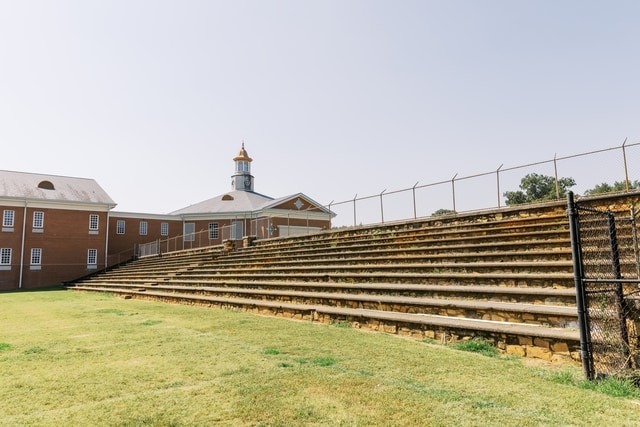Sites of Interest
The first home in Oxford was built by Dudley Snow in 1832. Shortly after, more families settled in the community, and more homes were built. Oxford was founded by hardworking farm laborers who lived in simple yet comfortable dwellings. The evolution of the home happened as the owner obtained more wealth, which ultimately resulted in the addition of rooms and ornamental embellishments. This process can be seen especially with the changes of the Dudley Snow House, Gunnels-Wingo House, and Davis C. Cooper House. Today, there are less than 15 homes in Oxford constructed prior to the Civil War. A handful of homes were built during the 1870s when locals regained their wealth after the losses of the war, and an influx of carpetbaggers migrated to the area. A majority of the homes in Oxford were built between 1880 and 1920. The largest residential areas are on Main Street, McPherson Street, Gray Street, McKibbon Street, and Second Street. Notable architectural styles include Greek Revival, Colonial Revival, Gothic Revival, Queen Anne Victorian, and Craftsman.
Clardy Mansion - 1880
621 College Street
Private Residence
Listed on the Alabama Register of Landmarks & Heritage.
This College Street home was built in 1880 by Zedekiah H. Clardy. The style of the home is modified Queen Anne Victorian constructed of locally handmade bricks. From the time of its construction until 1895, the home served as a boardinghouse for professors and students of Oxford College. It has been rumored that Ruth Elder- aviation pioneer, actress, and native of this area- lived in the home while attending Calhoun County High School.
Clardy-Yoe-Stewart House - c. 1860
312 Snow Street
Private Residence
Listed on the Alabama Register of Landmarks & Heritage.
This Snow Street home is a center-hall plan featuring modified Greek Revival architecture with early Victorian characteristics. The oldest portion of the home appears to be the rear rooms which were constructed about 1860. The home was owned by the Zedekiah H. Clardy family in the 1870s.
Clock - 2019
Corner of Main and Choccolocco Streets. Purchased by the City of Oxford at the completion of the streetscape project. Manufactured by Tuscumbia Iron Works in Florence, Alabama.
Coca-Cola Mural - 2018
601 Main Street
Replica of the original sign.

Davis C. Cooper House - 1911
301 Main Street
Private Residence
Listed on the Alabama Register of Landmarks & Heritage and the National Register of Historic Places.
This Main Street home was built in 1911 by Davis C. Cooper at the site of an earlier home. The style is a mix of Colonial Revival and Georgian Revival. In 1925, the home was modernized with indoor plumbing, electricity, and modifications to the exterior. The interior retains many original features from the 1920s renovation. Perhaps the most unusual about the house is the box ball alley and handmade primitive gazebo constructed with native trees and branches. Cooper served as Oxford's mayor from 1910-1929.
Dodson Presbyterian Church - 1857
801 Main Street
In 1856, a group of 11 met under the leadership of Rev. R.A. Houston to organise a Presbyterian church at Oxford. In 1857, John M. Forbes oversaw the construction of a church. It has been rumored that the church was part of the Underground Railroad. In 1891, the church underwent renovations to add modified High Victorian architecture with Gothic elements. Soon after the renovations were finished, lightening struck the bell tower and caused a fire. In April 1919, the church members voted to change its name to Dodson Memorial Presbyterian Church in honor of Professor John L. Dodson.
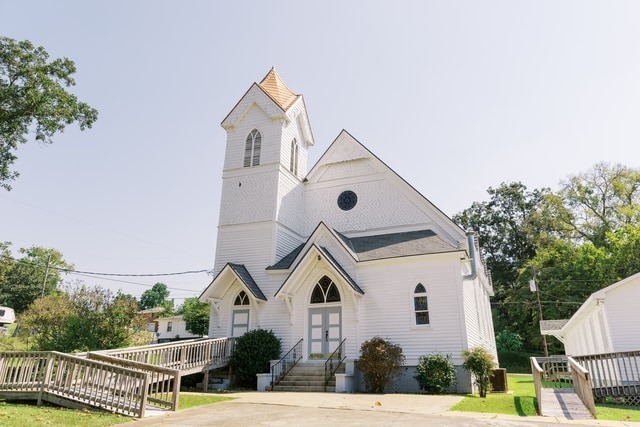
Eli Bridge Company Ferris Wheel - 1967
25 West Choccolocco Street
Private Property
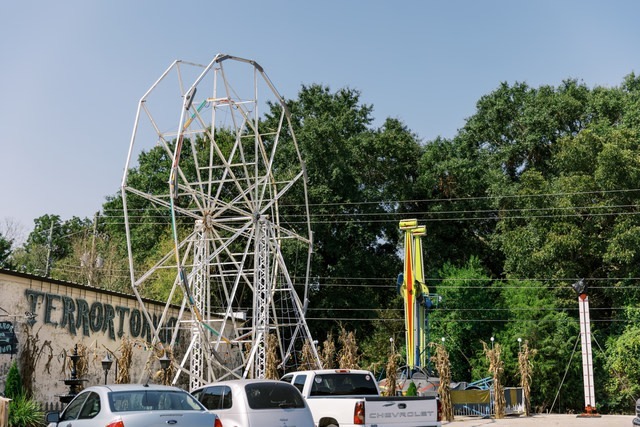
Oxford First United Methodist Church - c. 1870s
216 Snow Street
The Oxford First United Methodist Church was first organized around 1840. The original building- a hand-cut wooden board church with shutters- no longer exists, but the current building, erected in 1875, stands on the same grounds on Snow Street. The current church is of Normanesque architectural design with oversized handmade bricks. It has tall, round-arched windows and drip cornel cornices; the building is topped with a copper-sheathed dome and an iron weather vane.
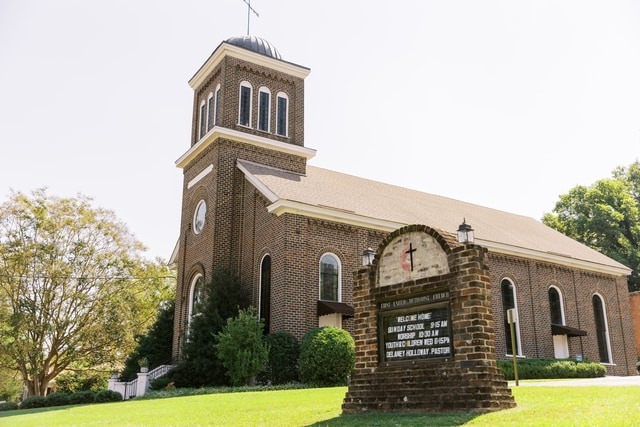
First Baptist Church of Oxford - 1910
95 East Oak Street
The First Baptist Church of Oxford was organized at the home of Benjamin Mattison in March 1836 as the Friendship Church. In 1841, a log meetinghouse was constructed for services. Due to an increase in membership, Elisha S. Simmons donated land for the construction of a new building in 1860. In March 1910, construction commenced on a new brick church to the east of the former building. The original 1910 structure still stands today.

"Greetings from Historic Main Street Oxford" mural - 2020
25 West Choccolocco Street
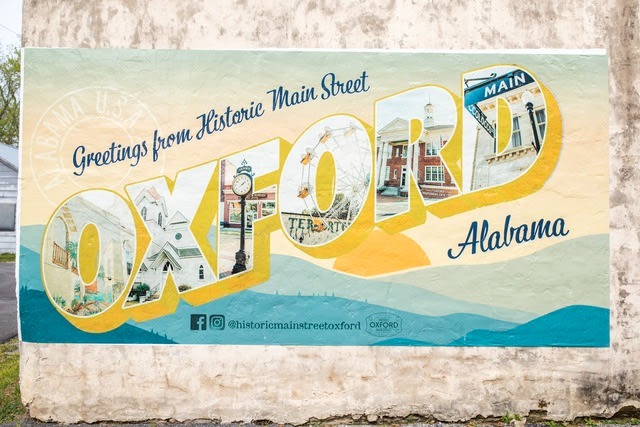
Gunnels-Wingo House - c. 1870s
225 East Oak Street
Private Residence
Listed on the Alabama Register of Landmarks & Heritage.
This Oak Street home was built in 1870 by Daniel P. Gunnels. It has been rumored that the center hall and lower-level portions were built much earlier, before the Civil War. The home is one of a handful remaining in Oxford constructed in the Gothic Revival architectural style. Gunnels moved to the Boiling Springs community, east of Oxford, and cooperated a mercantile business with Thomas J. Caver. In the 1860s, he established D.P. Gunnels & Others. The Gunnels building was the first brick structure in Oxford located at the corner of Main and Choccolocco Street.

"Hubbard Piano Co." Mural - c. 1980s
16 East Choccolocco Street
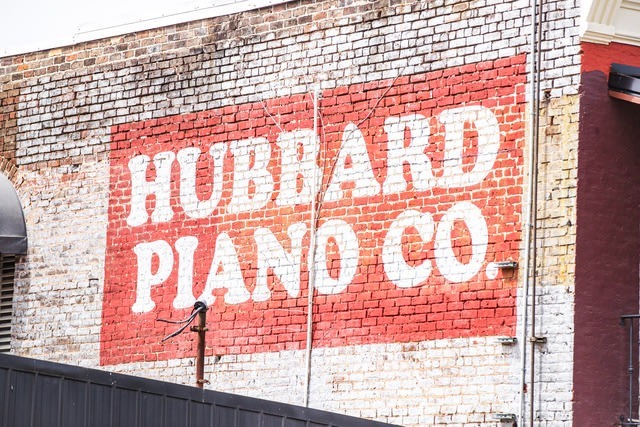
Mediterranean Mural - c. 2010s
500 Main Street
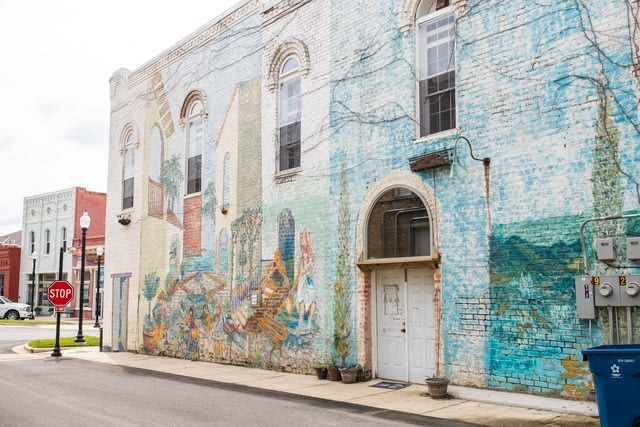
Patillo House - c. 1870
112 Gray Street
Private Residence
Listed on the Alabama Register of Landmarks & Heritage.
This Gray Street Greek Revival home was built in 1870 but has been rumored to have been much earlier, before the Civil War. In 1889, Luther Patillo, an Autauga County native, purchased the home and property for the purpose of his children being able to attend Oxford College. Patillo is the maternal grandfather of former First Lady Claudia "Lady Bird" Johnson.
Simmons Park - c. 1860s
400 Main Street
Public Park
Simmons Park was deeded to the City of Oxford in the 1860s for the purpose of a public park by Elisha S. Simmons. During the 1870s, it was used by cotton traders from Calhoun, Cleburne, Talladega, and Randolph Counties. Today the park hosts special and annual events by Historic Main Street Oxford.
The gazebo was purchased as a project by the Oxford Arts Council in 1990.

Oxford Train Depot - 1884
600 Barry Street
Private Property
In 1884 the East Tennessee, Virginia, and Georgia Railway (ETVG) constructed the modified Italianate depot and freight warehouse. The depot played a vital role in the development of Oxford's post-Civil War economy in transportation of cotton, iron, and people. The depot symbolically represents the "New South."
Oxford High School Stadium - 1934
310 East Second Street
Listed on the Alabama Register of Landmarks & Heritage
Constructed in 1934 by the Civil Works Administration (CWA) as a program under President Franklin D. Roosevelt's New Deal.
"It was erected at a cost of several thousands of dollars and has a seating capacity of 1,500 with a bathhouse on the north end. Being made of concrete, the risers are good for many years to come. The field has been made larger and is now level and sodded."
